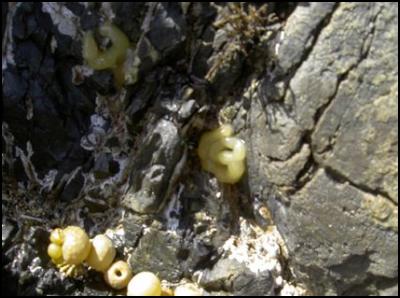Are sea creatures coping with the sun?
2 March 2007
Sunburnt or sunsmart – are sea
creatures coping with the sun?

Are
our rocky shore sea creatures getting sunburnt or are they
producing natural sunscreens to protect themselves from the
harmful effects of the sun?
Attempts to unravel this mystery will be revealed at a Marine Family Open Day at Wellington’s Island Bay on March 11 celebrating Seaweek (4-11 March) with its theme this year of One Ocean – it starts here – Kotahi Moana – Kei konei te timatatanga.
Being held at the Island Bay Surf Club, the event will highlight the research being undertaken by Victoria University of Wellington around Wellington’s south coast, part of which is being designated as the Kupe/Kevin Smith Marine Reserve.
Marine research displays, Marine Education Centre tours, snorkel tours, boat trips, games, talks and displays are also on offer at the open day, from 10am to 3.30pm.
It is being hosted by the Department of Conservation with support from Forest and Bird, Victoria University of Wellington, Island Bay Surf Lifesaving Club, Island Bay divers, Splash Gordon dive shop, and the Wellington Marine Conservation Trust, with sponsorship from The Body Shop, Rapid Copy and Lyall Bay Surf Club.
“We want to inspire people to enjoy and better understand the marine environment while also exploring ways to help look after it,” says DOC ranger and event organiser Matt Barnett.
The open day will provide an insight into the lives of the creatures that inhabit the rocky shore around the south coast… including molluscs, such as snails and limpits, which may be using natural sunscreens to protect themselves against increased ultraviolet (UV) radiation resulting from human-induced ozone depletion.
VUW Master of Science student Janine Russell, who is conducting the research, explains that molluscs lay egg masses right in the harsh intertidal zone where they can dry out at low tide.
“They do this on rocky shores around the world in summer but because of ozone depletion in New Zealand they are vulnerable to much higher ultra violet (UV) radiation than they have probably evolved to deal with. The levels here are up to two and a half times greater than in northern latitudes.
“We are looking at how this affects the development of these embryos and whether they have higher levels of microsporine-like amino acids, or MAAs, (natural sunscreens) than in similar species in the northern hemisphere.
Preliminary data suggests that some species' eggs are highly vulnerable to UV, and that they may have high levels of MAAs.”
Janine Russell says her research will help not only to better understand the impacts of UV radiation for New Zealand’s coastal marine life, and identify novel compounds to help combat this, but also to demonstrate whether, and by how much, they are at risk compared to elsewhere in the world.
“We know that UV radiation is extremely damaging for people but relatively little is known about how it impacts on our natural ecosystems.”
Co-ordinated by the New Zealand Environmental Education Association (NZAEE), Seaweek aims to raise awareness of the coast and ocean and encourages all New Zealanders to help look after their local marine areas, and think about how our actions can affect marine wildlife.
“What we do on land impacts on the health of the sea,” says Matt Barnett.
“Plastic and rubbish left on beaches or dropped in the sea kills our birds and marine animals if they swallow it or get entangled in it.”
Wellington City councillor and Wellington Conservation Board member Ray Ahipene-Mercer will be highlighting this at the Island Bay event with a talk on Looking after our seas and beaches.
Wellingtonians are privileged to have rich and varied marine environment so close at hand. Around 30 different species of whales, dolphins and seals have been reported in the region. Marine species make up almost one-third of New Zealand’s total number of described native species with more being discovered all the time. Maui’s and Hector’s dolphins and the New Zealand sea lion are only found here. And of the 83 species of fishes found in the rock pools, 54 occur only in New Zealand and virtually all the rest are restricted to Australasia.
A Seaweek celebration in Wellington’s Civic Square on March 5, a Marvellous Marine Day on the Kapiti Coast on March 11, library displays and story telling, and a penguin nest box creation day hosted by the Kiwi Conservation Club at Karori Wildlife Sanctuary on March 4 are among other events being held in the Wellington region during Seaweek.
For the full listing of Seaweek events in Wellington visit the NZAEE website: http://www.seaweek.org.nz/event_listing.htm#WELLINGTON_
ENDS


 Bill Bennett: Download Weekly - 100% claim lands One New Zealand in criminal court action
Bill Bennett: Download Weekly - 100% claim lands One New Zealand in criminal court action FSCL: Woman Scammed Out Of $25,000 After Job Offer On LinkedIn
FSCL: Woman Scammed Out Of $25,000 After Job Offer On LinkedIn NIWA: Cheers To Crustaceans - New Species Named After Welly Brewery
NIWA: Cheers To Crustaceans - New Species Named After Welly Brewery MBIE: Trans-Tasman Earth Observation Research Studies Confirmed
MBIE: Trans-Tasman Earth Observation Research Studies Confirmed NZ Association of Scientists: Royal Society Te Apārangi Governance Submissions Close - NZAS Submission
NZ Association of Scientists: Royal Society Te Apārangi Governance Submissions Close - NZAS Submission HortPlus: Project Aims To Improve Quality Of Weather Data In New Zealand
HortPlus: Project Aims To Improve Quality Of Weather Data In New Zealand



